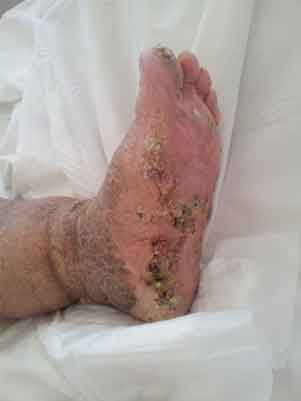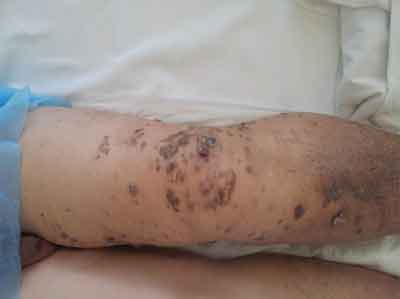*Konrad Wroński1, Przemysław Stefaniak2, Zbigniew Masłowski2, Leszek Frąckowiak1
Cutaneous Kaposi sarcoma – case report
1Department of Oncology, Faculty of Medicine, University of Warmia and Mazury, Olsztyn, Poland
Head of Department: prof. Sergiusz Nawrocki, MD, PhD
2Department of Surgical Oncology, Hospital Ministry of Internal Affairs with Warmia and Mazury Oncology Centre, Olsztyn, Poland
Head of Department: Andrzej Lachowski, MD
Summary
Classic Kaposi sarcoma is rare disease. First time it was described by Moriz Kaposi in 1872 as an idiopathic, multipigmented sarcoma of the skin. Typically, classic Kaposi sarcoma is observed in men from Sub-Saharan Africa, Eastern Europe or Middle Eastern descent. It is rare observed in North America and Northern Europe. Surgical biopsy is important in diagnosis of this neoplasm. Every patient with Kaposi sarcoma must have HIV test done. Treatment of Kaposi’s sarcoma evaluated from classic form for single lesion to experimental therapies. For patients with single lesion surgical biopsy is adequate treatment. Patients with a few lesions located nearby can be treated by single doses of radiation (from 8 to 12 Gy). Patients with widespread mucocutaneous disease, lymphedema or visceral disease are treated with systemic cytotoxic therapy. In this article the authors presented a case of a man who was admitted to the hospital because of classic cutaneous Kaposi sarcoma. The patient underwent surgery of the biggest skin tumor located in the left inguinal area which disturbed function normally every day.
INTRODUCTION
Kaposi sarcoma it is relatively rare disease in the world. This disease was first time described in 1872 as an idiopathic, multipigmented sarcoma of the skin (1). Typically, classic Kaposi sarcoma is observed in men from Sub-Saharan Africa, Eastern Europe or Middle Eastern descent (2, 3). It is rare that patient suffer from multifocal lesions in one leg. The authors of this article presented such HIV-negative patient.
CASE REPORT
A 60-year-old man, Caucasian race, was admitted to the Department of Surgical Oncology because of diagnosed cutaneous Kaposi sarcoma of the left leg and skin tumor in left inguinal area. In an interview with the patient, he informed us that tumor on the left leg was present for 3 months and gradually expanded. The patient reported no pain in this area. Surgical biopsy showed Kaposi sarcoma.
He had no any other symptoms, there was no history of weight loss and loss of appetite. The patient was not treated for chronically diseases. He had no surgeries before and there was no history of carcinoma in patient family. Blood test and other routine hematological examinations and biochemical tests were within normal limits. He was not HIV positive patient.
On physical examination, whole the left leg was with tumors (fig. 1 and 2). There were not enlarged inguinal lymph nodes. Also ultrasound examination of the inguinal lymph nodes did not show pathologically enlarged lymph nodes.

Fig. 1. Cutaneous Kaposi sarcoma of the left feet.

Fig. 2. Cutaneous Kaposi sarcoma of the left leg.
The patient was qualified for surgery. There was cut off tumor of the left inguinal area. The duration of surgery was 15 minutes. Pathological examination showed Kaposi sarcoma. Patient after surgery felt good and did not complain of pain. The postoperative period was uncomplicated and the patient left the ward in the first day after operation. The patient is in the care of outpatient surgical oncology and was qualified for chemotherapy.
DISCUSSION
Kaposi sarcoma was first time described by Moriz Kaposi, a Hungarian dermatologist, in 1872 as an idiopathic, multipigmented sarcoma of the skin (1). Typically, classic Kaposi sarcoma is observed in men from Sub-Saharan Africa, Eastern Europe or Middle Eastern descent (2, 3). It is rare observed in North America and Northern Europe (2, 3). This disease is observed more often in group of homosexual men and HIV-infected patients (4). It is observed that HIV-infected patients suffer from Kaposi sarcomas than patients with other acquired immunosuppression (5). There is also hypothesis about Kaposi’s sarcoma herpesvirus associated sexual transmission (5, 6).
Surgical biopsy is important in diagnosis of this neoplasm. Every patient with Kaposi sarcoma must have HIV test done. Treatment of Kaposi’s sarcoma evaluated from classic form for single lesion to experimental therapies. For patients with single lesion surgical biopsy is adequate treatment (7). Surgery plays important role when the tumor is located in one area or a few specific places which can be removed. Patients with a few lesions located nearby can be treated by single doses of radiation (from 8 to 12 Gy) (8, 9). Patients with widespread mucocutaneous disease, lymphedema or visceral disease are treated with systemic cytotoxic therapy (10, 11). The most common drugs are liposomal anthracyclines, paclitaxel, vinca alkaloids, and bleomycin (10, 11). Biologic agents as interferon alfa are now used as a first-line therapy for some patients with epidemic cutaneous Kaposi sarcoma (12). Subcutaneous, intravenous or intralesional interferon alfa all resulted in remissions is 20 to 60% (12, 13). Nowadays inhibitors of angiogenesis such as an inhibitor of vascular endothelial growth factor and thalidomide, and retinoids, such as all-trans-retinoic acid (tretinoin) and oral 9-cis-retinoic acid (LGD 1057), have been used in treatment against Kaposi’s sarcoma (14, 15).
Patients suffer from Kaposi sarcoma should be treated in high-specialized oncological centers where different therapies can be used.
Piśmiennictwo
1. Kaposi M: Idiopatische multiples Pigmentsarkom der Haut. Arch Dermatol Syph 1872; 3: 265-273. 2. Laor Y, Schwartz RA: Epidemiologic aspects of American Kaposi’s sarkoma. J Surg Oncol 1979; 12: 299-303. 3. Ross RK, Casagrande JT, Dworsky RL et al.: Kaposi’s sarcoma in Los Angeles, California. J Natl Cancer Inst 1985; 75: 1011-1015. 4. Beral V: Epidemiology of Kaposi’s sarcoma. Cancer Surv 1991; 10: 5-22. 5. Beral V, Peterman TA, Berkelman RL et al.: Kaposi’s sarcoma among persons with AIDS: a sexually transmitted infection? Lancet 1990; 335: 123-128. 6. Chang Y, Cesarman E, Pessin MS et al.: Identification of herpesviruslike DNA sequences in AIDS-associated Kaposi’s sarcoma. Science 1994; 266: 1865-1869. 7. Brenner B, Rakowsky E, Katz A et al.: Tailoring treatment for classical Kaposi’s sarcoma: comprehensive clinical guidelines. Int J Oncol 1999; 14: 1097-1102. 8. Lo TC, Salzman FA, Smedal MI, Wright KA: Radiotherapy for Kaposi’s sarcoma. Cancer 1980; 45: 684-687. 9. Nisce LZ, Safai B, Poussin-Rosillo H: Once weekly total and subtotal skin electron beam therapy for Kaposi’s sarcoma. Cancer 1981; 47: 640-644. 10. Volberding PA, Abrams DI, Conant M et al.: Vinblastine therapy for Kaposi’s sarcoma in the acquired immunodeficiency syndrome. Ann Intern Med 1985; 103: 335-338. 11. Gill PS, Rarick M, McCutchan JA et al.: Systemic treatment of AIDS related Kaposi’s sarcoma: results of a randomized trial. Am J Med 1991; 90: 427-433. 12. Abrams DI, Volberding PA: Alpha interferon therapy of AIDS-associated Kaposi’s sarcoma. Semin Oncol 1986; 13 (suppl. 2): 43-47. 13. de Wit R, Danner SA, Bakker PJ et al.: Combined zidovudine and interferon-alpha treatment in patients with AIDS-associated Kaposi’s sarcoma. J Intern Med 1991; 229: 35-40. 14. Soler RA, Howard M, Brink NS et al.: Regression of AIDS-related Kaposi’s sarcoma during therapy with thalidomide. Clin Infect Dis 1996; 23: 501-505. 15. Saiag P, Pavlovic M, Clerici T et al.: Treatment of early AIDS-related Kaposi’s sarcoma with oral all-trans-retinoic acid: results of a sequential non-randomized phase II trial. AIDS 1998; 12: 2169-2176.

